In this article, we will share MP Board Class 10th Science Solutions Chapter 3 Metals and Non-metals Pdf, These solutions are solved subject experts from the latest edition books.
MP Board Class 10th Science Solutions Chapter 3 Metals and Non-metals
MP Board Class 10th Science Chapter 3 Intext Questions
Intext Questions Page No. 40
Mp Board Class 10 Science Chapter 3 Question 1.
Give an example of a metal which:
- Is a liquid at room temperature.
- can be easily cut with a knife.
- Is the best conductor of heat.
- Is a poor conductor of heat.
Answer:
- Metal that exists in a liquid state at room temperature → Mercury.
- Metal that can be easily cut with a knife → Sodium.
- Metal that is the best conductor of heat → Silver.
- Metals that are poor conductors of heat → Lead.
Science Class 10 Mp Board Solutions Question 2.
Explain the meanings of malleable and ductile.
Answer:
- Malleable: Materials that can be beaten into thin sheets are called malleable.
- Ductile: Materials that can be drawn into thin wires are called ductile.
Metals can be hammered into thin sheets. This property of a metal is called malleability and the metals showing this property are called malleable. Gold, Silver, Copper, aluminium etc are malleable metals. Metals can be drawn into wires. The ability of metals to be drawn into thin wires is called ductility. Gold is the most ductile metal. It is interesting to know that a wire of about 2 km length can be drawn from one gram of gold.
Intext Questions Page No. 46
Mp Board Solution Science Class 10th Question 1.
Why is sodium kept immersed in kerosene oil?
Answer:
Sodium is highly reactive metal. It catches fire if kept in the open. Hence, to protect this to prevent accidental fires, it is kept immersed in kerosene oil.
Mp Board Solution Class 10 Question 2.
Write equations for the reactions of:
Iron with steam.
Calcium and potassium with water.
Answer:
- 3Fe(s) + 4H2O(g) ➝ Fe3O4(aq) + 4H2(g)
- Ca(s) + 2H2O(l) ➝ Ca(OH)2(aq)+ H2(g)+ Heat
2K(s) + 2H2O(l) ➝ 2KOH(aq) + H2(g) + Heat
Mp Board Solution Class 10th Science Question 3.
Samples of four metals A, B, C and D were taken and added to the following solution one by one. The results obtained have been tabulated as follows.

Use the table above to answer the following questions about metals A, B, C and D.
- Which is the most reactive metal?
- What would you observe if B is added to a solution of Copper(II) sulphate?
- Arrange the metals A, B, C and D in the order of decreasing reactivity.
Answer:
- B is most reactive metal.
- If B is added to a solution of copper sulphate it displaces copper from copper sulphate.
- If metals are written in the order of decreasing reactivity it is B > A > C > D.
Mp Board 10th Science Solution Question 4.
Which gas is produced when diluting hydrochloric acid is added to a reactive metal? Write the chemical reaction when iron reacts with dilute H2SO4.
Answer:
Hydrogen gas is evolved when diluting hydrochloric acid is added to a reactive metal. When iron reacts with dilute H2SO4, Iron(II) sulphate with the evolution of hydrogen gas is formed.
Fe(s) + H2SO4aq) → FeSO4(aq) + H2(g)
Science Mp Board Class 10 Question 5.
What would you observe when zinc is added to a solution of iron(II) sulphate? Write the chemical reaction that takes place.
Answer:
Zinc is more reactive than iron. When zinc is added to iron (II) sulphate, then it will displace the iron from iron sulphate solution as shown in the following chemical reaction,
Zn(s) + FeSO4(aq) → ZnSO4(aq) + Fe(s)
Intext Questions Page No. 49
Class 10th Mp Board Science Question 1.
(i) Write the electron-dot structures for sodium, oxygen and magnesium.
(ii) Show the formation of Na2O and MgO by the transfer of electrons.
(iii) What are the ions present in these compounds?
Answer:
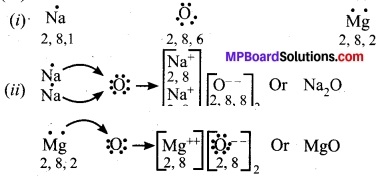
(iii) The ions present in Na2O are Na+ and O2- ions and MgO are Mg2+
and O2- ions.
Mp Board Solution.Com Class 10 Question 2.
Why do ionic compounds have high melting points?
Answer:
Ionic compounds have high melting points because there is electrostic forces of attraction between their charges.
Intext Questions Page No. 53
Mp Board Solution Class 10 Science Question 1.
Define the following terms:
- Mineral
- Ore
- Gangue
Answer:
- Mineral: Compounds which occur Naturally are called minerals.
- Ore: Metals can be obtained from minerals. These are called ores.
- Gangue: Ores mined from the earth are usually contaminated with large amounts of impurities such as soil, sand etc., called gangue.
Class 10th Science Mp Board Question 2.
Name two metals which are found in nature in the free state.
Answer:
The metals at the bottom of the reactivity series are mostly found in a free state. For example gold, silver, and platinum.
Mp Board Science Class 10th Science Solutions Question 3.
What chemical process is used for obtaining a metal from its oxide?
Answer:
Metal can be extracted from its oxide by the process of reduction.
Intext Questions Page No. 55
Mp Board Science Class 10th Question 1.
Metallic oxides of zinc, magnesium and copper were heated with the following metals.
| Metal | Zinc | Magnesium | Copper |
| Zinc oxide | – | – | – |
| Magnesium oxide | – | – | – |
| Copper oxide | – | – | – |
In which cases will you find displacement reactions taking place?
Answer:
| Metal | Zinc | Magnesium | Copper |
| Zinc oxide | No reaction | Displacement | No reaction |
| Magnesium oxide | No reaction | Displacement | No reaction |
| Copper oxide | Displacement | Displacement | No reaction |
Mp Board Solution Class 10th Question 2.
Which metals do not corrode easily?
Answer:
Silver and Gold are not corrode easily.
Class 10th Mp Board Science Solution Question 3.
What are alloys?
Answer:
An alloy is a homogeneous mixture of two or more metals, or a metal and a non-metal. For example, brass is an alloy of copper and zinc.
MP Board Class 10th Science Chapter 3 Ncert Textbook Exercises
Mp Board Class 10th Science Solution Question 1.
Which of the following pairs will give displacement reactions?
(a) NaCl solution and copper metal.
(b) MgCl2 solution and aluminium metal.
(c) FeSO4 solution and silver metal.
(d) AgNO3 solution and copper metal.
Answer:
(d) AgNO3 solution and copper metal.
Class 10 Mp Board Science Solution Question 2.
Which of the following methods is suitable for preventing an iron frying pan from rusting?
(a) Applying grease
(b) Applying paint
(c) Applying a coating of zinc
(d) all of the above.
Answer:
(c) Applying a coating of zinc
Mp Board Class 10 Science Question 3.
An element reacts with oxygen to give a compound with a high melting point. This compound is also soluble in water. The element is likely to be:
(a) Calcium
(b) Carbon
(c) Silicon
(d) Iron
Answer:
(a) Calcium
Mp Board Class 10 Science Solution Question 4.
Food cans are coated with tin and not with zinc because:
(a) Zinc is costlier than tin.
(b) Zinc has a higher melting point than tin.
(c) Zinc is more reactive than tin.
(d) Zinc is less reactive than tin.
Answer:
(c) Zinc is more reactive than tin.
Question 5.
You are given a hammer, a battery, a bulb, wires and a switch.
- How could you use them to distinguish between samples of metals and non-metals?
- Assess the usefulness of these tests in distinguishing between metals and non-metals.
Answer:
- Metals can be spread into sheets with the help of a hammer while non metals give powder. When metals are connected into circuit using battery, bulb, wires and a switch current passes through the circuit and the bulb glows.
- Hammer is a reliable method because no non metal can be spread into sheet.
Question 6.
What are amphoteric oxides? Give two examples of amphoteric oxides.
Answer:
Metal oxides which react with both acids as well as bases to produce salt and water are known as amphoteric oxides.
Eg: Al2O3 – Aluminium oxide
ZnO – Zinc Oxide.
Question 7.
Name two metals which will displace hydrogen from dilute acids, and two metals which will not.
Answer:
Iron and Aluminium are more reactive than Hydrogen and displace hydrogen from dilute acids. Mercury and copper re less reactive and these do not displace hydrogen from dilute acids.
Question 8.
In the electrolytic refining of a metal M, what would you take as the anode, the cathode and the electrolyte?
Answer:
In the electrolytic refining of a metal, M:
- Anode → Impure metal, M.
- Cathode → Thin strip of pure metal, M.
- Electrolyte → Aqueous solution of a salt of the metal, M.
Question 9.
Pratyush took sulphur powder on a spatula and heated it. He collected the gas evolved by inverting a test tube over it, as shown in the figure below.
(a) What will be the action of gas on:
- Dry litmus paper?
- Moist litmus paper?
(b) Write a balanced chemical equation for the reaction taking place.
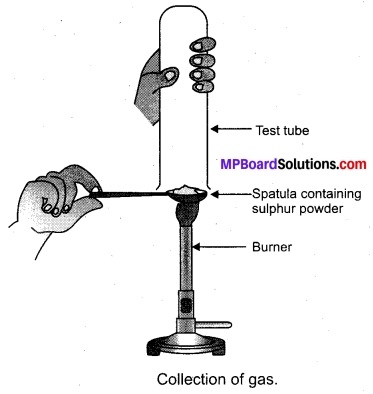
Answer:
(a)
- There will be no action on dry litmus paper.
- The colour of litmus paper will turn red because sulphur is a non-metal and the oxides of non-metal are acidic in nature.
(b) 
Question 10.
State two ways to prevent the rusting of iron.
Answer:
Two ways to prevent the rusting or iron are
(a) Applying oil, paint and grease we can prevent rusting.
(b) By coating with zinc to iron, we can prevent using. This is called Galvanisation.
Question 11.
What type of oxides are formed when non-metals combine with oxygen?
Answer:
When non-metals are combined with oxygen then neutral or acidic oxides are formed. Examples of acidic oxides are NO2, SO2 and examples of neutral oxides are NO, CO etc.
Question 12.
Give reasons:
- Platinum, gold and silver are used to make jewellery.
- Sodium, potassium and lithium are stored under oil.
- Aluminium is a highly reactive metal, yet it is used to make utensils for cooking.
- Carbonate and sulphide ores are usually converted into oxides during the process of extraction.
Answer:
1. Platinum, gold and silver are used to make jewellery because they are very lustrous. Also, they are very less reactive, ductile and do not corrode easily.
2. Sodium, potassium, and lithium are very reactive metals and react very vigorously with air and water. Therefore, they are kept immersed in oil.
3. Though aluminium is a highly reactive metal, it is resistant to corrosion. This is because aluminium reacts with oxygen present in the air to form a thin layer of aluminium oxide. This oxide layer is very stable and prevents further reaction of aluminium with oxygen. Also, it is light in weight and a good conductor of heat.
Hence, it is used to make cooking utensils.
4. Carbonate and sulphide ores are usually converted into oxides during the process of extraction because metals can be easily extracted from their oxides rather than from their carbonates and sulphides.
Question 13.
You must have seen tarnished copper vessels being cleaned with lemon or tamarind juice. Explain why these sour substances are effective in cleaning the vessels.
Answer:
Copper reacts with moist carbon dioxide in the air and slowly tosses its shiny brown surface and gains a green coat. This green substance is basic copper carbonate. Citric acid and tartaric acid neutralise copper carbonate. Hence citric or tartaric acid are effective in cleaning the vessel.
Question 14.
Differentiate between metal and non-metal on the basis of their chemical properties.
Answer:
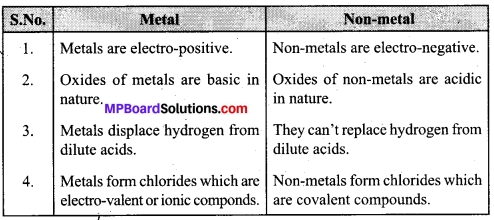
Question 15.
A man went door to door posing as a goldsmith. He promised to bring back the glitter of old and dull gold ornaments. An unsuspecting lady gave a set of gold bangles to him which he dipped in a particular solution. The bangles sparkled like new but their weight was reduced drastically. The lady was upset but after a futile argument, the man beat a hasty retreat. Can you play the detective to find out the nature of the solution he had used?
Answer:
The solution he had used was Aqua regia. Aqua regia is a Latin word which means ‘Royal Water’. It is the mixture of concentrated hydrochloric acid and concentrated nitric acid in the ratio of 3:1. It is capable of dissolving metals like Gold and Platinum. Since the outer layer of the gold bangles is dissolved in aqua regia, so their weight was reduced drastically.
Question 16.
Give reasons why copper is used to making hot water tanks and not steel (an alloy of iron).
Answer:
Iron do not react with hot water, but reacts with steam and forms metallic oxide and Hydrogen. But copper do not reacts with water. Hence copper is used to make hot water tanks and not steel (an alloy of iron).
MP Board Class 10th Science Chapter 3 Additional Questions
MP Board Class 10th Science Chapter 3 Multiple Choice Questions
Question 1.
What kind of element is carbon?
(a) Metal
(b) Metalloid
(c) Non-metal
(d) An alloy
Answer:
(c) Non-metal
Question 2.
A metal of daily use which does not get rusted is:
(a) Steel
(b) Iron
(c) Gold
(d) Silver
Answer:
(a) Steel
Question 3.
Liquid non-metal at room temperature:
(a) Oxygen
(b) Nitrogen
(c) Mercury
(d) Bromine
Answer:
(c) Mercury
Question 4.
Steel is primarily made up of:
(a) Fe and C
(b) Cu and C
(c) Fe and S
(d) Zn and C
Answer:
(a) Fe and C
Question 5.
Silver is coated over iron in electroplating, it represents:
(a) Silver is more reactive than Iron.
(b) Iron is more reactive than silver.
(c) Both are equally reactive
(d) None of above.
Answer:
(b) Iron is more reactive than silver.
Question 6.
Brass is an alloy of:
(a) Cu and Mn
(b) Cu and Zn
(c) Cu and Fe
(d) Cu, Fe and Zn.
Answer:
(b) Cu and Zn
Question 7.
During electrolytic refining of a metal, metal gets deposited at:
(a) Anode
(b) Cathode
(c) Solution
(d) None
Answer:
(b) Cathode
Question 8.
What basic physical property can differentiate metal and non-metal?
(a) Hardness
(b) Lustre
(c) Both (a) and (b)
(d) None
Answer:
(c) Both (a) and (b)
Question 9.
We can cut ………. metal with an ordinary knife:
(a) Sodium
(b) Carbon
(c) Gold
(d) Silver
Answer:
(a) Sodium
Question 10.
Hardest metal present in our nature is:
(a) Gold
(b) Diamond
(c) Tungsten
(d) Copper
Answer:
(c) Tungsten
Question 11.
Lustrous non-metal is:
(a) Oxygen
(b) Nitrogen
(c) Iodine
(d) Gold
Answer:
(c) Iodine
Question 12.
Iron pyrites contain which constituent other than Fe:
(a) Co
(b) Cl
(c) S
(d) Pt
Answer:
(c) S
Question 13.
When a metal reacts with water, it forms:
(i) Metal
(ii) H2
(iii) Metal hydroxide
Choose the best combination:
(a) (i) and (ii)
(b) (i) and (iii)
(c) (ii) and (iii)
(d) All
Answer:
(c) (ii) and (iii)
Question 14.
Metal forms salts when it reacts with:
(a) Acid
(b) Water
(c) Another Metal
(d) Oxygen
Answer:
(a) Acid
Question 15.
What kinds of metals are coin metals (Cu, Ag, Au)?
(a) Most reactive
(b) Non-reactive
(c) Least reactive
(d) None
Answer:
(c) Least reactive
Question 16.
What kinds of metals are noble metals?
(a) Most reactive
(b) Non-reactive
(c) Least reactive
(d) None
Answer:
(b) Non-reactive
Question 17.
Arrange the following metals in descending order of reactivity – Na, Al, Au, H:
(a) Na > Al > Au>H.
(b) H < Au < Al < Na.
(c) Au > Al > Na > H.
(d) Na > Al > H > Au.
Answer:
(b) H < Au < Al < Na.
Question 18.
When a metal reacts with oxygen, it forms:
(a) Hydrated metals
(b) Metal oxides
(c) Non-metals
(d) Oxygen
Answer:
(b) Metal oxides
Question 19.
Which metal violently reacts with cold water?
(a) Cu and Ag
(b) Au and Ag
(c) K and Na
(d) Hg
Answer:
(c) K and Na
Question 20.
Metals that do not react with water at all are:
(a) Alkali metal
(b) Alkaline eater
(c) Lanthanides
(d) Coin metals
Answer:
(d) Coin metals
Question 21.
Aluminium develops a thin layer of oxide when exposed to air, this process is called:
(a) Anodization
(b) Amalgamation
(c) Corrosion
(d) Rancidity
Answer:
(c) Corrosion
Question 22.
When water reacts with metal, which gas is evolved in the reaction?
(a) Oxygen
(b) Hydrogen
(c) Nitrogen
(d) Sulphur dioxide
Answer:
(b) Hydrogen
Question 23.
What will be the missing product of the following reaction?
Ca(s) + 2H2O– → Ca(OH)2(aq) + ….
(a) O2
(b) CaO
(c) H2
(d) O3
Answer:
(c) H2
Question 24.
Which solution or reagent can dissolve gold and platinum?
(a) Conc. H2SO4
(b) Conc. HCl
(c) Conc. HNO3
(d) Aqua regia
Answer:
(d) Agua regia
Question 25.
Benchmark element of the reactivity series is –
(a) Au
(b) H
(c) Na
(d) Fe
Answer:
(b) H
Question 26.
Elements more electropositive in nature are:
(a) Metals
(b) Non-metals
(c) Metalloids
(d) None
Answer:
(a) Metals
Question 27.
Ionic solids are:
(a) Solid and hard
(b) Having high boiling and melting point
(c) Both (a) and (b)
(d) None
Answer:
(c) Both (a) and (b)
Question 28.
Which one of the following represents electron dot structures of sodium?

Answer:
(d) M
Question 29.
Carefully observe the given diagram below:
![]()
Choose the best compound to show above electron-dot structure bonding:
(a) NaCl
(b) MgCl2
(c) H2O
(d) None
Answer:
(c) H2O
Question 30.
Ore of metals with high reactivity can be separated by:
(a) Roasting
(b) Calcination
(c) Electrolysis
(d) Reduction process
Answer:
(c) Electrolysis
Question 31.
Thermionic reactions are:
(a) Displacement reactions of highly exothermic nature
(b) Endothermic reaction
(c) Both (a) and (b)
(d) Electrolytic reduction reactions.
Answer:
(c) Both (a) and (b)
Question 32.
Rusting is an example of:
(a) Electrolysis
(b) Calcination
(c) Corrosion
(d) None
Answer:
(c) Corrosion
Question 33.
Which compounds of metals are basic in nature?
(a) Hydrides
(b) Chlorides
(c) Cyanides
(d) Oxides
Answer:
(d) Oxides
Question 34.
When metal reacts with water which gas is liberated?
(a) Oxygen
(b) Hydrogen
(c) Metal oxide
(d) All of these
Answer:
(b) Hydrogen
Question 35.
Which of the following gas is produced when dilute H2SO4 reacts with iron?
(a) Oxygen gas
(b) Hydrogen gas
(c) Both
(d) None of these
Answer:
(b) Hydrogen gas
Question 36.
What happen when Zinc is added to iron (II) sulphate Zn(s) + Fe(s):
(a) ZnSO2 + FeO2
(b) ZnSO2(aq) + Fe(s)
(c) ZnFe + 2Ov
(d) None
Answer:
(b) ZnSO2(aq) + Fe(s)
Question 37.
Choose the best reason from the following for why ionic compounds have high melting points:
(a) Electrostatic forces
(b) Low magnetic forces
(c) (a) and (b) both
(d) None of these
Answer:
(a) Electrostatic forces
Question 38.
Which of the following is gangue?
(a) Water
(b) Metals
(c) Rocks
(d) CO2
Answer:
(c) Rocks
Question 39.
Sodium, potassium and lithium are:
(a) Very less reactive
(b) More reactive and react with air
(c) Easily converted to oxides
(d) None
Answer:
(b) More reactive and react with air
Question 40.
Choose from following ways to prevent the rusting of iron:
(a) Oiling
(b) Greasing
(c) Galvanisation
(d) All (a), (b) and (c)
Answer:
(d) All (a), (b) and (c)
Fill in the blanks:
- Metal generally give ……………Oxides when dissolved in water.
- Li, Na and K are …………… metals.
- K and Na catch fire when exposed to ……….
- Ag and Au ………….. react with water at all.
- Aluminium is positioned ……………. hydrogen in reactivity series.
- …………………….. is called royal water.
- Metal is displaced from their ……………… or …………….. form.
- Metal gives salt when it reacts with…….
- Hydrogen is not liberated when metal reacts with ……….. acid.
- Ionic compounds are ……………………….. in water.
- Ionic compounds are hard but …………….. in nature hence break into pieces when pressure is applied.
- Earth’s …………….. is main source of metal.
- Minerals containing metals are called ……………….
- Sulphide ores contain metals with ………………. reactivity.
- Carbonate ore is converted to their metal oxides by the process of …………
- Electrolysis is done to the ores of ……………….. reactivity to obtain pure metal.
- Impurities such as soil, sand etc. are called …………… in the ore.
- Bronze is a homogeneous mixture of ……………… and …………….
Answers:
- basic
- soft
- air
- do not
- above
- Aqua regia
- solution, molten
- alkali
- nitric acid
- soluble
- brittle
- crust
- Ores
- low
- Calcination
- high
- gangue
- copper, tin
MP Board Class 10th Science Chapter 3 Very Short Answer Type Questions
Question 1.
Which one is the most abundant element in our earth crust?
Answer:
Oxygen.
Question 2.
Write the names of two diatomic gaseous elements.
Answer:
- Oxygen, O2.
- Nitrogen, N2.
Question 3.
Is any metal known in gaseous form, in its natural conditions?
Answer:
No.
Question 4.
Name two naturally occurring soft metals.
Answer:
Sodium, magnesium.
Question 5.
Which metal shows poor conductivity?
Answer:
Tungsten [W] or Bismuth (Bi].
Question 6.
Which non-metal conducts electricity?
Answer:
Graphite.
Question 7.
Which metal forms amphoteric oxides when reacted with oxygen?
Answer:
Aluminium, Zinc, etc.
Question 8.
Draw an electron dot structure of SO2.
Answer:

Question 9.
Give an example of metal oxide’s reaction with water.
Answer:
All metal oxides do not react with water but some metal oxides react with water to give alkali. For example, Na and K.
Na2O(s) + H2O(l) → 2NaOH(aq)
Question 10.
Give an example of amphoteric oxides.
Answer:
Al2O3.
Question 11.
Give a term to the following:
A process in which a carbonate ore is heated at very high temperature to get metal oxide.
Answer:
Roasting.
Question 12.
How less reactive metal oxides are reduced?
Answer:
Less reactive metal oxides are reduced by reducing agents like aluminium.
Question 13.
Give a reaction in which metal hydroxide is formed.
Answer:
‘Na’ directly reacts with hydrogen gas and forms sodium hydride.
2Na + H2 → 2NaH.
Question 14.
Give an example for each an alloy and amalgam.
Answer:
- Alloy – Steel.
- Amalgam – Sodium Amalgam. (Alloy of mercury and sodium).
Question 15.
What do we call the removal of gangue from the ore?
Answer:
Enrichment of ores.
Question 16.
What is the place of less reactive metals in metal reactivity series?
Answer:
Less reactive metals are arranged at the bottom of the series.
Question 17.
Name two metals which can replace iron in electroplating.
Answer:
Gold and silver.
Question 18.
What kind of compounds has the highest melting and boiling points?
Answer:
Ionic compounds.
Question 19.
What corrodes copper?
Answer:
Moist carbon-dioxide corrodes copper.
Question 20.
Iron pillar of Qutub Minar, Delhi is prevented against rusting. Why?
Answer:
The corrosion-resistant nature is due to protective film at the non-rust interface because of high phosphorus content.
Question 21.
Why every metal has a different rate of reactivity with the same chemical or reactant? (HOTS)
Answer:
Every metal has different electronic configuration and different electro-positivity or ion forming capability, so metal reactivity differs from each other.
MP Board Class 10th Science Chapter 3 Short Answer Type Questions
Question 1.
Why can we draw gold to thin wire form?
Answer:
Gold is a metal and metal has the ability to be drawn in very thin wire or sheets without being broken, this property of a metal is called ductility. Gold is the most ductile metal.
Question 2.
What is a semiconductor?
Answer:
There are some elements known to us which are neither metal nor nonmetals, they alter their properties with the different physical and chemical environment provided. Normally, they behave as non-metals and show insulation property but when provided with extra energy, they start behaving as metal and show conduction. Example: Silicon.
Question 3.
What do you know about amphoteric oxides?
Answer:
Metal oxides which produce salts in both cases, either react with acid or base are termed amphoteric oxides.
Question 4.
What is gangue? Why is it important to remove them before the extraction process?
Answer:
Impurities associated with ores such as sand, soil etc. are called gangue. The original compound becomes bulkier with their presence and extraction of pure metal consumes lots of energy and time. Hence, gangue is removed before the extraction process.
Question 5.
Give an example of displacement reaction used for extraction of metal from its oxide.
Answer:
Highly reactive metals are used to reduce metal oxide to the metal in an electrolytic displacement reaction.
Example:
3MnO2(s) + 4Al(s) → 3Mn(l) + 2Al2O3
Here, aluminium helps in extraction of pure Mn.
Question 6.
Explain the reactivity series of metals in brief.
Answer:
All metals are arranged in an order on the basis of reactivity. This series represents displacing ability of one metal to displace other from its compound form when it undergoes an electrolytic displacement reaction.
Question 7.
How metal and non-metal interact to form salts?
Answer:
When metal and non-metal interact, they form ionic compounds. Metal tends to lose an electron and form positive ion while non-metal forms a negative ion and a bond is formed due to strong electrostatic forces of attraction among two ions.
Question 8.
How can we protect metals corrosion?
Answer;
Prevention from corrosion can be done by painting, oiling, greasing, galvanizing and electroplating etc. on the metal. All these processes stop the interaction of outer layer of air with metal.
Question 9.
What is galvanisation?
Answer:
Galvanisation is a protection technique against metal corrosion. In this process, metal is coated with a thin layer of zinc.
Question 10.
Why pure gold is mixed with silver or copper while making jewellery?
Answer:
Pure gold metal is very soft. So, jewellery will be brittle if used in the same form. Impurity of other metal in nominal percentage makes the metal harder and ready to use and it does not appear very different than the pure one.
Question 11.
What is an amalgam?
Answer:
When one component of any alloy is mercury it is called amalgam.
Question 12.
Why alloys are not used as conductance medium of electricity?
Answer:
Alloys are not used as conductance medium of electricity because of electrical conductivity and melting point of an alloy is lesser than the pure metal.
Question 13.
Why cooking utensils are made up of metals and their handle or knobs with non-metal materials? (HOTS)
Answer:
Metals are good conductors of heat. So, when utensil made of metals are pulled over a flame, they spread heat energy evenly and food gets cooked properly. But handles or knobs are made of non-metals because they are bad conductors of heat and give us ease to work with highly heated utensils so that we can hold them easily while cooking.
Question 14.
Why ageing is a natural phenomenon? (HOTS)
Answer:
The oxygen of the atmosphere react with the outer skin of body fat and carbohydrate, hence continuously degrade it. Similarly inside the body for the energy need, carbohydrate and body fat undergo oxidation process and get continuously decomposed which causes ageing, so ageing is a natural phenomenon.
Question 15.
Neha went to market with her grandmother to purchase some cooking utensils for their family’s wedded couple. Grandmother started buying cooking utensils made of copper and iron but Neha suggested her to take utensils made of steel. (VBQ)
- How is steel better than copper?
- What kind of corrosion occurs in Cu?
- What values does Neha show in this act?
Answer:
- Steel is an alloy. It does not get corroded or spoiled with time and it is cheap too.
- Cu forms its oxide when it comes in contact with oxygen and turns green in colour.
- Neha shows awareness about metal of more usability and durability.
MP Board Class 10th Science Chapter 3 Long Answer Type Questions
Question 1.
Draw line diagrams for the steps involved in the extraction of metals.
Answer:
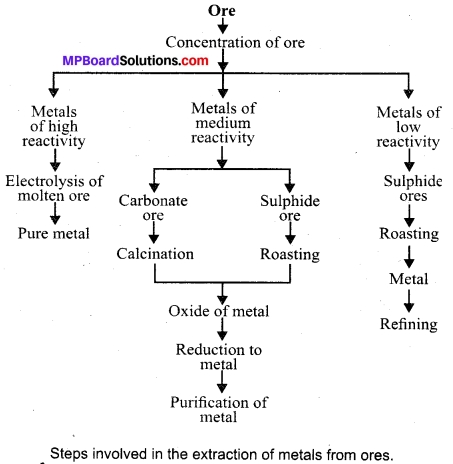
Question 2.
Write short notes on the following:
- Roasting
- Calcination
- Mineral
- Anodising
Answer:
1. Roasting:
To extract metal of medium reactivity from its sulphide ore, the ore is heated strongly in the presence of air and this extraction process is called roasting.
2. Calcination:
When medium reactivity metal is extracted from its carbonate ore by heating moderately, the process is known as calcination.
3. Mineral:
Naturally occurring compounds of metals and non-metals in various combinations are called minerals.
4. Anodising:
When aluminium is exposed to air it develops a thick layer of oxides and turns green in colour.
Question 3.
Rupam was painting the garden chair and other pots made with iron at his home, his younger brother asked him why he is doing so and wasting his time:
- What is your view about his work?
- What are other methods to protect the metal from corrosion?
- What values does Rupam express in this way?
Answer:
- Rupam was painting the garden’s metal objects to protect them from corrosion.
- Oiling, euchre plating, anodizing etc. are other methods.
- Rupam was doing a great job protecting the metal from degrading because it can give a long life to objects and save money.
MP Board Class 10th Science Chapter 3 Textbook Activities
Class 10 Science Activity 3.1 Page No. 37
- Take samples of iron, copper, aluminium and magnesium. Note the appearance of each sample.
- Clean the surface of each sample by rubbing them with sandpaper and note their appearance again.
Observations:
Iron, copper, aluminium and magnesium have lustre which clearly appears on rubbing them with sandpaper.
Class 10 Science Activity 3.2 Page No. 37
- Take small pieces of iron, copper, aluminium, and magnesium. Try to cut these metals with a sharp knife and note your observations.
- Hold a piece of sodium metal with a pair of tongs.
Caution:
- Always handle sodium metal with care. Dry it by pressing between the folds of a filter paper.
- Put it on a watch-glass and try to cut it with a knife.
- What do you observe?
Observations:
Only Na and Mg are soft metals and we can cut them with a knife but other metals are hard. de
Class 10 Science Activity 3.3 Page No. 38
- Take pieces of iron, zinc, lead and copper.
- Place any one metal on a block of iron and strike it four or five times with a hammer.
- What do you observe?
- Repeat with other metals.
- Record the change in the shape of these metals.
Observations:
Fe, Zn, Pb and Cu are metals and show proper malleability when hammered.
Class 10 Science Activity 3.4 Page No. 38
List the metals whose wires you have seen in daily life.
Observations:
Lead cannot be drawn to a thin wire. But Fe, Cu and Al are ductile.
Class 10 Science Activity 3.5 Page No. 38
- Take an aluminium or copper wire. Clamp this wire on a stand, as shown in the figure.
- Fix a pin to the free end of the wire using wax.
- Heat the wire with a spirit lamp, candle or a burner near the place where it is clamped.
- What do you observe after some time?
- Note your observations. Does the metal wire melt?
Observations:
- The pin fell down because heat is being conducted.
- The metal wire does not melt.
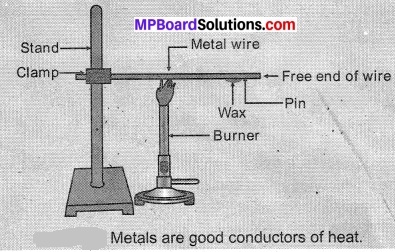
Class 10 Science Activity 3.6 Page No. 39
- Set up an electric circuit as shown in the figure.
Place the metal to be tested in the circuit between terminals A and B as shown. - Does the bulb glow? What does this indicate?
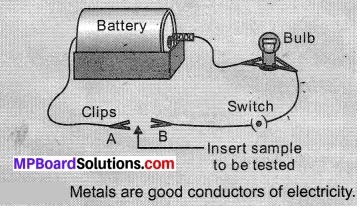
Observations:
Yes, the bulb glows as metals are a good conductor of heat and electricity.
Class 10 Science Activity 3.7 Page No. 39
- Collect samples of carbon (coal or graphite), sulphur and iodine.
- Take samples of iron, copper, aluminium and magnesium. Note the appearance of each sample.
- Clean the surface of each sample by rubbing them with sandpaper and note their appearance again.
- Take small pieces of iron, copper, aluminium, and magnesium. Try to cut these metals with a sharp knife and note your observations.
- Hold a piece of sodium metal with a pair of tongs.
Caution:
- Always handle sodium metal with care. Dry it by pressing between the folds of a filter paper.
- Put it on a watch-glass and try to cut it with a knife.
- What do you observe?
- Take pieces of iron, zinc, lead and copper.
- Place any one metal on a block of iron and strike it four or five times with a hammer.
- What do you observe?
- Repeat with other metals.
- Record the change in the shape of these metals.
- Set up an electric circuit as shown in the figure.
- Place the metal to be tested in the circuit between terminals A and B as shown.
- Does the bulb glow? What does this indicate?

Observations:
- Yes, the bulb glows as metals are a good conductor of heat and electricity.
- List the metals whose wires you have seen in daily life.
- Iron, copper, aluminium and magnesium have lustre which clearly appears on rubbing them with sandpaper.
- Only Na and Mg are soft metals and we can cut them with a knife but other metals are hard.
- Fe, Zn, Pb and Cu are metals and show proper malleability when hammered.
Class 10 Science Activity 3.8 Page No. 40
- Take a magnesium ribbon and some sulphur powder.
- Burn the magnesium ribbon. Collect the ashes formed and dissolve them in water.
- Test the resultant solution with both red and blue litmus paper.
- Is the product formed on burning magnesium acidic or basic?
- Now burn sulphur powder. Place a test tube over the burning sulphur to collect the fumes produced.
- Add some water to the above test tube and shake.
- Test this solution with blue and red litmus paper.
- Is the product formed on burning sulphur acidic or basic?
- Can you write equations for these reactions?
Observations:
(i)
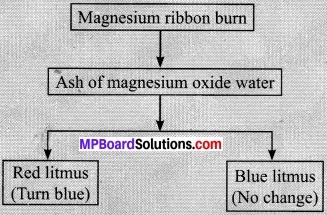
Result: Oxide of metal is basic.
(ii)
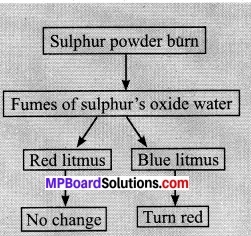
Result: Oxide of non-metal is acidic.
Class 10 Science Activity 3.9 Page No. 41
Caution:
- The following activity needs the teacher’s assistance. It would be better if students wear eye protection.
- Hold any of the samples taken above with a pair of tongs and try burning over a flame. Repeat with the other metal samples.
- Collect the product if formed.
- Let the products and the metal surface cool down.
- Which metals burn easily?
- What flame colour did you observe when the metal burnt?
- How does the metal surface appear afterburning?
- Arrange the metals in the decreasing order of their reactivity towards oxygen.
- Are the products soluble in water?
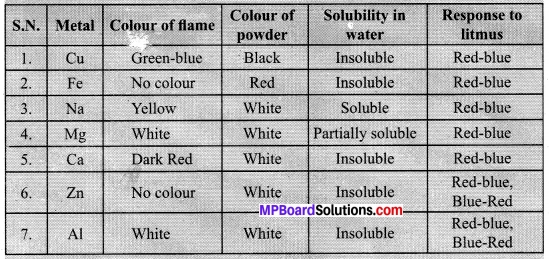
Only Zn and Al form amphoteric oxide (in nature) other metals forms basic oxides.
Class 10 Science Activity 3.10 Page No. 42
Caution:
- This Activity needs the teacher’s assistance.
- Collect the samples of the same metals as in Activity 3.9.
- Put small pieces of the samples separately in beakers half-filled with cold water.
- Which metals reacted with cold water?
- Arrange them in the increasing order of their reactivity with cold water.
- Did any metal produce fire on water?
- Does any metal start floating after some time?
- Put the metals that did not react with cold water in beakers half-filled with hot water.
- For the metals that did not react with hot water, arrange the apparatus as shown in the figure and observe their reaction with steam.
- Which metals did not react even with steam?
- Arrange the metals in the decreasing order of reactivity with water.
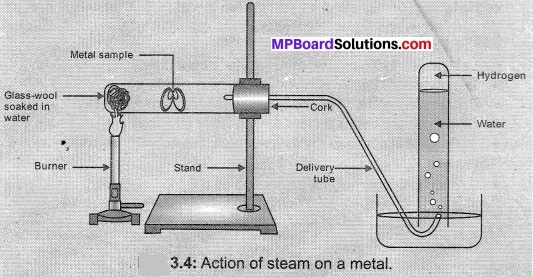
Observations:
- Metals which reacted with cold water → Na, K and Ca.
- Metals which produced fire → Na and K.
- Metals which started floating after some time → Ca and Mg.
- Metals which reacted with hot water → Mg.
- Metals which did not react with steam also → Pb, Cu, Ag and Au.
- Arranging reactivity of metals in ascending order:
K > Na > Ca > Mg > Al > Zn > Fe
Class 10 Science Activity 3.11 Page No. 44
Caution:
- Do not take sodium and potassium as they react vigorously even with cold water.
- Put the samples separately in test tubes containing dilute hydrochloric acid.
- Suspend thermometers in the test tubes, so that their bulbs are dipped
in the acid. - Observe the rate of formation of bubbles carefully.
- Which metals reacted vigorously with dilute hydrochloric acid?
- With which metal did you record the highest temperature?
- Arrange the metals in the decreasing order of reactivity with dilute acids.

- Collect all the metal samples except sodium and potassium again. If the samples are tarnished. rub them clean with sandpaper.
Class 10 Science Activity 3.12 Page No. 44-45
- Take a clean wire of copper and an iron nail.
- Put the copper wire in a solution of iron sulphate and the iron nail in a solution of copper sulphate taken in test tubes figure.
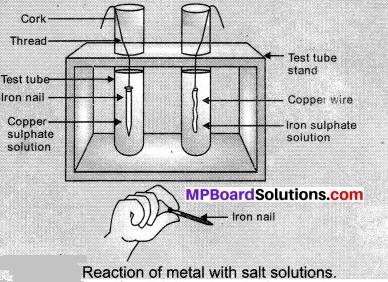
- Record your observations after 20 minutes.
- In which test tube did you find that a reaction has occurred? On what basis can you say that a reaction has actually taken place?

- Only Zn and Al form amphoteric oxide (in nature) other metals forms basic oxides.
- Metals which reacted with cold water → Na, K and Ca.
- Metals which produced fire → Na and K.
- Metals which started floating after some time → Ca and Mg.
- Metals which reacted with hot water → Mg.
- Metals which did not react with steam also → Pb, Cu, Ag and Au.
- Arranging reactivity of metals in ascending order:
K > Na > Ca > Mg > Al > Zn > Fe
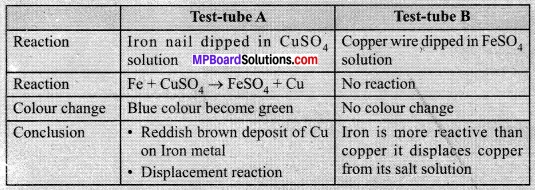
- Write a balanced chemical equation for the reaction that has taken place.
- Name the type of reaction.
Observations:
- In these above observations show iron is more reactive than copper.
Fe(s) + CuSO4(aq) → Cu(s) + FeSO4(aq) - In the given set-up (A) and (B) reactivity of metals is as follows:
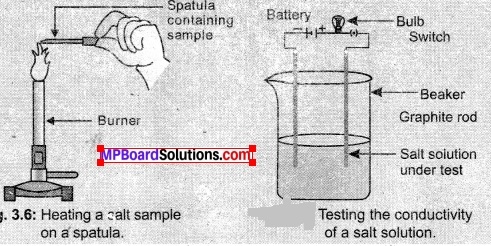
Class 10 Science Activity 3.13 Page No. 48
- Taķe samples of sodium chloride, potassium iodide, barium chloride or any other salt from the science laboratory.
- What is the physical state of these salts?
- Take a small amount of a sample on a metal spatula and heat directly on the flame figure. Repeat with other samples.
Observations:

- What did you observe? Did the samples impart any colour to the flame? Do these compounds melt?
- Try to dissolve the samples in water, petrol and kerosene. Are they soluble?
- Make a circuit as shown in figure (testing the conductivity of a salt solution) and insert the electrodes into a solution of one salt. What did you observe? Test the other salt samples too in this manner.
- What is your inference about the nature of these compounds? Sodium chloride, potassium iodide and barium chloride give the following observation:
Class 10 Science Activity 3.14 Page No. 53
- Take three test tubes and place clean iron nails in each of them.
- Label these test tubes A, B and C. Pour some water in test tube A and cork it.
- Pour boiled distilled water in test tube B, add about 1 ml of oil and cork it. The oil will float on water and prevent the air from dissolving in the water.
- Put some anhydrous calcium chloride in test tube C and cork it. Anhydrous calcium chloride will absorb the moisture, if any, from the air. Leave these test tubes for a few days and then observe (Figure).
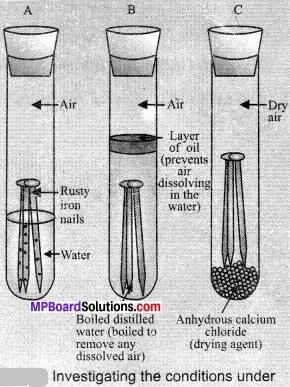
Observations:
Set of 3 test tube A, B and C are given below:
- Test tube A: Iron nail became rusty.
Presence of water and air in test-tube A: Air and water are both exposed. - Test tube B: Iron nail do not become rusty.
Presence of water and air in test-tube B: Due to layer of oil, air does not expose. - Test tube C: Iron nail do not become rusty.
Presence of water and air in test-tube C: Air and water both are not present.
Conclusion:
- Test-tube A: Iron nail become rusty due to exposure to air and water.
- Test-tube B: Iron nail exposed with water but not with air, so the iron nail does not rust.
- Test-tube C: Iron nail not exposed to air and water, so iron nail do not rust.
So, air and water both are required for an iron nail to rust.